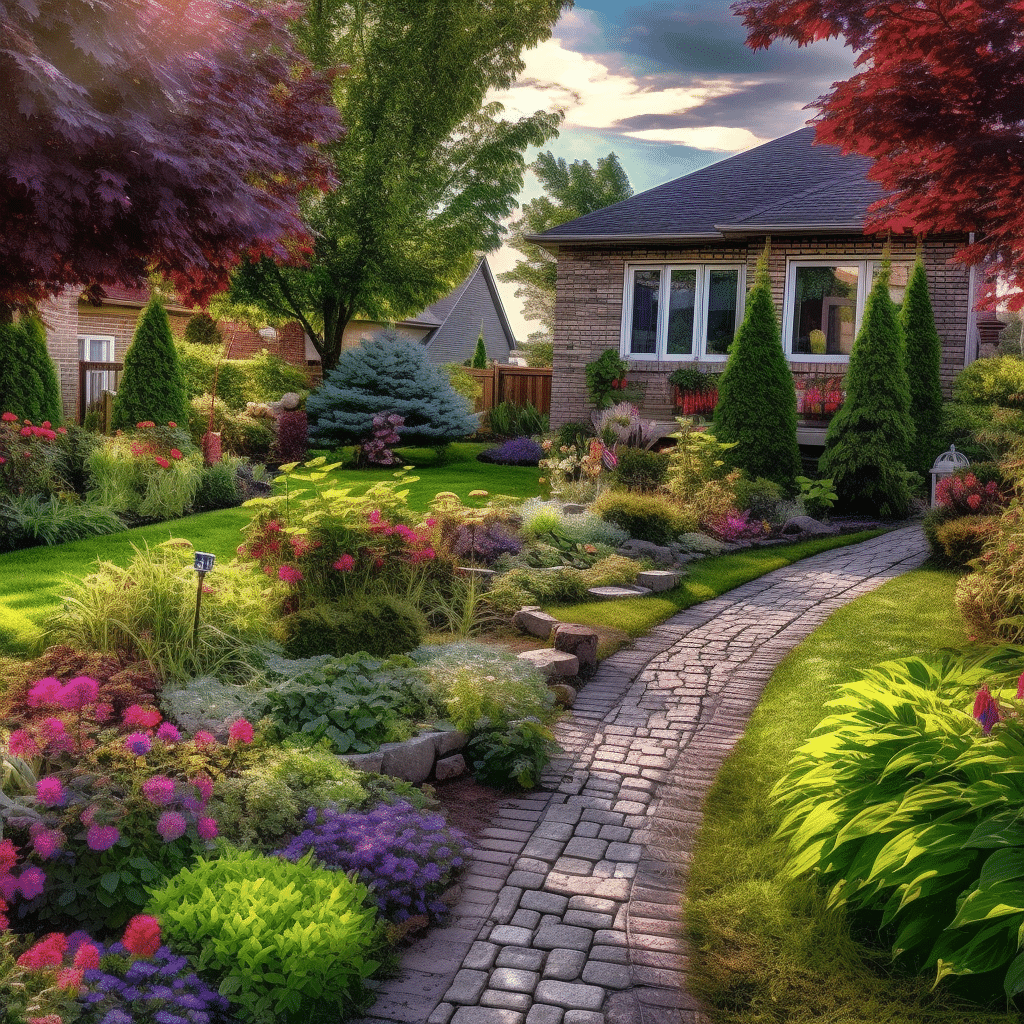.jpg)
Table of Contents
The Importance of Landscaping Maintenance
Landscaping maintenance is key to keeping outdoor spaces beautiful and functional. It involves regular care to keep gardens, lawns, and landscapes looking their best. Maintenance ensures plants stay healthy and well-cared for.
The benefits of landscaping maintenance are many:
- An attractive landscape promotes positive impressions and adds curb appeal, increasing the property’s value.
- Regular maintenance keeps weeds and pests away – trimming shrubs and trees, removing unwanted plants, and applying insecticides as needed.
Plus, it’s eco-friendly. Native plants and sustainable practices like proper irrigation, composting, and mulching conserve water and reduce waste.
For efficient maintenance, make a schedule for routine tasks like mowing, pruning, and watering. This will help you stay on top of landscaping duties. Revenge against Mother Nature? Pull those weeds with satisfaction!
Common Landscaping Maintenance Tasks
For some sweat-inducing work, seasonal landscaping maintenance is the way to go. Regular mowing in blazing heat strengthens character and encourages a fetching sweat mustache! Pruning and trimming shrubs, trees, and hedges boosts visual appeal and prevents overgrowth. Adding mulch retains soil moisture and adds nutrients to plants, while regular weeding keeps unwanted plants away.
In addition to these tasks, it’s important to check irrigation systems for leaks or damage. Adequate watering keeps plants healthy. Also, look out for pests and diseases to prevent any potential damage.
Here’s how to get the best out of your landscaping maintenance:
- Set up a regular maintenance schedule to make sure tasks don’t get neglected.
- Hire experts for complex tasks like tree pruning and irrigation system installation.
- Adapt maintenance practices to seasonal changes, like changing watering schedules during dry seasons.
By following these tips, your outdoor space will be beautiful and functional for years to come. Consistent care preserves its beauty and function!
Seasonal Landscaping Maintenance
Regularly pick up fallen leaves and debris. Cut back overgrown branches and shrubs for a neat look and healthy growth. Nourish the soil with the right nutrients in each season. Inspect the irrigation system to avoid leaks and make sure plants get the right amount of water. Shield delicate plants from extreme weather by adding insulation or bringing them inside.
Remember: to keep your landscape looking great, you must understand each season’s special needs. Customize your upkeep plans for the best results. Don’t wait until it’s too late – take action now and see your property flourish! Landscaping maintenance – it’s the secret to happy plants and happier homeowners.
Common Landscaping Issues and Solutions
Landscaping maintenance is key to keeping your outdoor space beautiful. Let’s have a look at common problems and solutions.
If there’s not enough water, plants can get dry and unhealthy. Get an efficient irrigation system in place, like sprinklers or drip systems.
Weeds can take over quickly. Check often and remove them fast.
Insects and pests can cause damage and disease. Use organic sprays or biological controls to keep ’em away!
Excessive rainfall or poor drainage can lead to soil erosion. Put in retaining walls or create natural slopes to control the water flow.
Certain diseases can affect plants’ health. Diagnose issues early and treat with the right fungicides or treatments.
When vegetation gets out of control, it’s time to trim. Regularly trim shrubs, trees, and plants to keep them looking neat.
Unique things to consider when maintaining your landscape include using native plants that are better adapted to the area, mulch to conserve moisture, and sustainable practices such as composting.
Pro Tip: Cultivate your garden beds with a rake. This helps aerate the soil and encourages healthy root growth.
Sustainable Landscaping Practices
It’s essential to think about the maintenance needed for sustainable landscaping. Prune trees and shrubs to keep them healthy and to help them stay in their natural form, using minimal resources.
There are other practices that make up sustainable landscaping too; such as:
- Choosing plants native to the area, which boosts biodiversity and reduces the need for water and chemicals.
- Using smart irrigation systems that adjust to weather conditions, collecting rainwater, and growing drought-tolerant plants.
- Mulching, composting, and soil testing to improve water retention and plant growth, and reduce the need for synthetic fertilizers.
The EPA states that sustainable landscaping can reduce water usage by up to 50% compared to traditional landscapes. So why not get professionals to make your yard look fabulous?
Hiring Professional Landscapers
Hiring professional landscapers for your property’s upkeep might be a smart move. They possess the know-how and expertise to give your outdoor areas a great look. Here is what to think about when employing professional landscapers:
- Skillset: Years of practice in their field mean they can provide you with informed counsel and advice.
- Abilities: Landscaping involves a mix of planting, pruning, and designing. Pro landscapers have perfected these abilities.
- Time-saving: Taking care of a big property can be tedious. Hiring pros will save you time for other activities while still keeping your outdoor area looking neat.
- Equipment: Certain tools and machinery are needed for landscaping. Professional landscapers come with all the necessary gear.
- Personalization: Each property is distinctive. Professional landscapers will work with you to create a customized landscape plan to fit your desires. They also stay up to date on the newest trends and techniques. This way they can integrate new ideas into your landscape design for a modern, attractive look.
When choosing a professional landscaper, do some research and ask for recommendations from people who have used them. Read online reviews to learn more about their quality of work and reputation. Once you select a professional landscaper, make sure to clearly communicate your goals. Regular communication during the project ensures everyone is on the same page.
DIY Landscaping Maintenance Tips
Maintaining landscapes can be a challenge, but these DIY tips will get you to a flourishing, beautiful garden. Start with mowing and edging. Trim the grass to the right height for health and vibrancy. Mulch around plants and trees for weed control and water retention. Prune shrubs and trees often to promote growth and improve the landscape’s look. Water deeply but less often to encourage deep roots and reduce water waste. Check for pests and disease, then treat any issues quickly.
For a unique touch, add decorative elements like flower beds, pathway lighting, or a backyard fountain. Remember that landscapes have individual needs, considering climate, soil, and plant species when maintaining.
My neighbor’s story is a great example of DIY maintenance. He hadn’t been caring for his garden for months, but then he decided it was time for a change. He made a verdant oasis with a shovel and determination.
So, you can maintain your landscape without spending a fortune or getting help. With effort and creativity, you can create an outdoor sanctuary that’ll dazzle neighbors and passersby. Get creative and enjoy the zen of landscaping maintenance!
The Cost of Landscaping Maintenance
Landscaping maintenance can be pricey, but it’s a must for the best look of your outdoor space. Knowing the cost factors helps you plan and budget. Here are the costs to consider:
- Labor: The biggest cost is usually labor. Professionals charge based on the size, complexity and duration of the project.
- Materials: Plants, trees, mulch, soil, fertilizers, tools and equipment all cost money. The quality and quantity impacts the expenses.
- Regular upkeep: Mowing, weeding, trimming hedges, general garden work – these all need attention monthly or seasonally.
- Specialized services: Pest control, irrigation system maintenance, tree pruning – all require extra care and cost.
Location, plant types, climate – all these can affect the cost too. Jason thought his picturesque yard would be cheaper to maintain. He learned his lesson – homeowners should research their landscaping costs before starting.
Landscaping Maintenance for Different Types of Properties
Landscaping maintenance is essential for all kinds of properties. Residential, commercial or industrial – each one needs proper upkeep to create an inviting atmosphere.
Here’s a breakdown of the key maintenance tasks for each type:
Residential:
- Regular lawn mowing and edging
- Pruning
- Weed control
- Seasonal flower planting
Commercial:
- Lawn care
- Parking lot cleaning
- Irrigation system maintenance
- Tree trimming and removal
- Landscape design upgrades
Industrial:
- Dust and debris removal
- Erosion control measures
- Preventive pest management
To have an exquisite landscape, regardless of property type, regular maintenance must be done according to its specific requirements. Professional landscaping services can help ensure a visually appealing environment that leaves a lasting impression on visitors. Invest in proper landscaping maintenance today and start experiencing its benefits!
Conclusion: The Key to a Beautiful and Well-Maintained Landscape
Create a mesmerizing outdoor space with a beautiful, well-maintained landscape. Careful planning and attention to detail are required. To keep your landscape healthy and vibrant, maintenance is essential.
Maintain a lush and green lawn by mowing, watering, and fertilizing. Trim shrubs and trees for an attractive shape and to prevent overcrowding. Additionally, removing weeds prevents them from competing with desired plants for nutrients.
Irrigation is essential for survival. Install an efficient sprinkler system or use drip irrigation to conserve water and give each plant the right amount of moisture. Monitor soil moisture levels to avoid overwatering or underwatering.
Take care of pest and disease issues immediately. Inspect plants for signs of damage or infestation, and use organic pest control methods.
You can also benefit from mulching. It conserves moisture, regulates soil temperature, suppresses weed growth, and improves soil health.
Transform your landscape into a captivating oasis. Dedicate time each week to its care and witness the remarkable rewards firsthand. Experience the joy of nature and elevate the beauty and ambiance of your surroundings. Start today!

